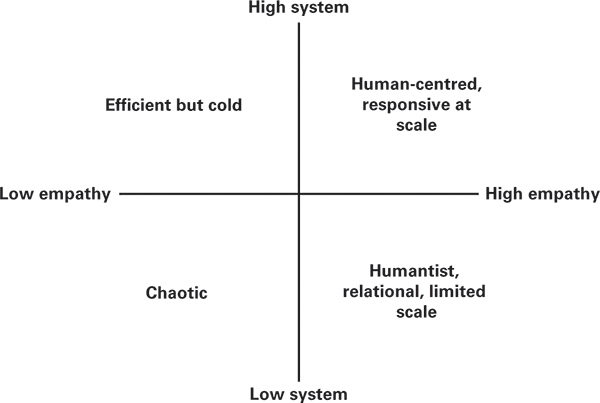PART FOUR
Flexibility
In this Part we consider the role of people, culture, structures, resourcing in enabling and facilitating change.
Flexibility – adaptable, able to be easily modified to respond to altered circumstances, to bend without breaking, workable, malleable, supple, ready and able to change.
Defining flexibility
In 2014, author and social innovator Charles Leadbeater wrote a paper (The London Recipe: How systems and empathy make the city)1 that attempted to define the key facets or ingredients that combined to create a successful city. Some of the best recipes, said Leadbeater, comprise two key ingredients (like eggs and bacon or fish and chips) and so it is with cities that a combination of two factors that determine success or failure – systems and empathy:
Systems oil cities. Without effective power, transport, health and education systems, cities fall apart. But it’s empathy that makes cities human.2
We need systems to ‘bring together disparate interacting components to achieve a common purpose’, to have processes and methods, to make everything work easily and reliably at scale, and to gain efficiencies. Life is chaotic without shared systems. And yet we also depend on the ‘dark matter’ of empathy, our capacity for insight, affinity, rapport, to understand and find common ground, to collaborate, cooperate and engage in sharing and exchange.
The city, Leadbeater said, is at its absolute best when it combines both of these things, where ‘lots of people use efficient systems to have a highly convivial, charged, shared experience’ (Figure P4.1).
Figure P4.1 Systems and empathy

Success comes from this combination of both systems and empathy (Leadbeater used the London Olympics in 2012 as an example of when efficiency of large-scale systems combined with very human connections and approaches to great effect). System-heavy entities may look impressive but they can often feel dead. Empathy brings in the countless small and large acts that make large systems human.
In his paper, Leadbeater talks about how a key challenge when building systems is how to scale empathy. A city, like a large organization, is a social system in that it comprises lots of people interacting in different ways. Interactions between elements over time become systems when they naturally evolve to develop a set of understood and recognized boundaries that help define them. These emergent conditions help to guide and shape the way in which the system operates and may then become more rigidly defined rules. But as this scales the factors that once created the value in relations and interactions can be challenged, undermined or corrupted so that we lose connection, intimacy and empathy.
Organizations are systems but in the digital age, now more than ever, they need empathy at scale to survive and thrive. To become a truly agile organization, therefore, we need structured systems and efficiency but we need to combine that with human-centred approaches, processes and experiences. Trying to introduce agile into a non-agile culture will not work unless we face the human-centred challenges that will inevitably arise. Trying to create change without bringing people on the journey with you will lead to failure. Attempting to become more responsive as an organization without accepting the need to think differently about the fluidity of resourcing will not work.
To become more agile we need the human-centred flexibility in culture, resourcing and behaviours to create the environment in which change can really happen. Put simply:
(velocity × focus) – flexibility = failure
Notes
1 Charles Leadbeater (1 April 2014) The London Recipe: How systems and empathy make the city, Centre for London.org, [Online] http://www.centreforlondon.org/publication/london-recipe/ [accessed 25 October 2016]
2 Charles Leadbeater (29 April 2014) Charles Leadbeater: It’s small things that make our big city what it is, Evening Standard, [Online] http://www.standard.co.uk/comment/comment/charles-leadbeater-it-s-small-things-that-make-our-big-city-what-it-is-9301446.html [accessed 25 October 2016]